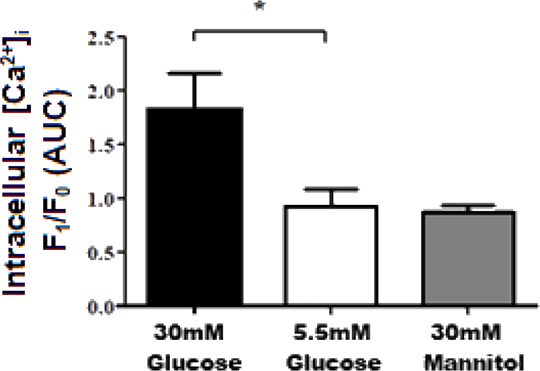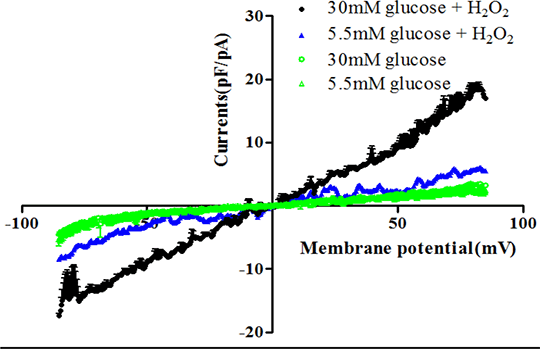High glucose enhanced ROS-evoked Ca 2+ influx through TRPM2 in U937 human monocyte Hyperglycemia has been implicated in mediating proinflammatory environments in diabetes and might be a significant factor in the development of the metabolic disorder (1). TRPM2 (transient receptor potential melastatin 2) is a non-selective Ca2+-permeable cation channel activated by intracellular messengers such as adenosine diphosphate ribose (ADPR) and reactive oxidative species (ROS) such as hydrogen peroxide (H2O2) to serve as oxidative stress sensor (2). TRPM2 is abundantly expressed in monocytes and ROS-evoked Ca2+ influx via TRPM2 is associated with chemokines production in monocyte (3). The aim of this study was to investigate if high glucose environment will alter the characteristics of ROS-evoked Ca2+ influx via TRPM2 in human monocyte cell line U937. U937 cells were pre-incubated in normal glucose concentration (5.5mM), high glucose (30mM) or mannitol (30mM) for 48 h and then challenged by H2O2 (1mM). Intracellular Ca2+ concentration ([Ca2+]i) was measured by calcium imaging in U937 loaded with Fura-4. Voltage-dependent Ca2+ influx into U937 cell was recorded by whole cell patch clamp. H2O2-induced intracellular [Ca2+]i changes was significantly enhanced in high glucose condition (Fig.1, P<0.05). [Ca2+]i was recorded from a different cell under different condition (n=8). Similarly, H2O2-evoked Ca2+ influx via TRPM2 was also significantly increased in high glucose condition (Fig. 2, P<0.05). Cells were pre-incubated in 5.5mM (n=8) or 30mM (n=8) and currents were activated by application of H2O2 for 5 seconds.
Fig.1 Effect of high glucose on H2O2-induced [Ca2+]i change. 
Fig.2 Effect of high glucose on TRPM2-like current. 
In summary, high glucose might alter the physiological activity of TRPM2 in monocytes which might enhance the generation of proinflammatory environment under oxidative stress challenge. This project was funded by MYRG124(Y1-L3)-ICMS12-HPM. (1) Styskal J, Van Remmen H, Richardson A et al. (2012) Free Radical Biology & Medicine 52: 46–58. (2) Adriana ST and Reinhold P. (2011) J Physiol 589.7: 1515–1525. (3) Shinichiro Y, Shunichi S, Shigeki K et al. (2008) Nat Med. 14(7): 738–747.
|



